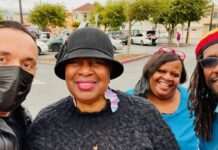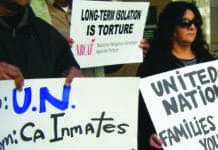We can’t allow ‘violent criminal’ rhetoric to justify leaving some of the most vulnerable people in dangerous conditions.
This piece is a commentary, part of The Appeal’s collection of opinion and analysis. Before we get to it, though, note this news reported today, April 1, 2020:
Releasing 3,500 is not enough! Response of Californians United for a Responsible Budget (CURB) to Gov. Gavin Newsom’s plan to accelerate prison discharges in an effort to reduce crowding as coronavirus infections begin spreading through the state prison system
by Amber-Rose Howard

CURB celebrates each release that Gov. Gavin Newsom has used his executive authority to grant in the face of COVID-19. In New York, Gov. Andrew Cuomo has not expressed half of the urgency to protect public health as Newsom has in California.
However, with over 122,000 people incarcerated in the California Department of Corrections (CDCR), 3,500 expedited parole dates does not impact the prison population nearly enough to slow the spread of the COVID-19 pandemic.
There are positive cases of the virus at 10 of the 35 prisons in California, currently affecting 25 staff and four prisoners. If Gov. Newsom’s intent is to take “extraordinary and unprecedented protective measures” to slow the spread of the virus and protect those who live and work within California’s 35 prisons, he must not continue to exclude people who are convicted of violent offenses.
Tens of thousands of people are serving decades under the Three-Strikes Law, over 5,000 people are serving a Life Without the Possibility of Parole (LWOP) sentence and over 30,000 people are 50 years of age and older in CDCR. Granting commutations for thousands of elders and medically vulnerable people, including those serving an LWOP or other life sentence, would be extraordinary, unprecedented and a life-saving move, protecting the health of people across California.
Amber-Rose Howard, director of CURB, can be reached at amber@curbprisonspending.org.
A plea to Gov. Newsom

by James King, state campaigner for the Ella Baker Center for Human Rights
As a person who just four months ago was serving a life sentence under California’s Three Strikes law, my thoughts, anxieties and fears are primarily with the people I left behind. I was, to use Gov. Gavin Newsom’s recent language, a person he would consider a “violent criminal.”
Today, California is incarcerating thousands of elderly and infirm people in their 50s, 60s, 70s and even 80s. These are the people who are still living out the consequences of California’s failed “tough on crime” era of the 1980s and ‘90s and have not seen much relief under the sentencing reforms that former Gov. Jerry Brown came to embrace in his second term.
I recall meeting Gov. Newsom, while he was lieutenant governor, at an event in San Quentin State Prison. He ate lunch with us, took pictures and talked to people for hours. I’ll never forget how much it meant to those of us who were incarcerated that a person who had risen to the second-highest office in the state would take the time to treat us like humans.
After decades of being demonized, here was a person of importance, saying we were not our worst act, and that redemption is possible. That Newsom came inside and took the time to be polite and charming gave each of us hope that, one day, our broader society would also realize that we were redeemable. His kindness helped us believe that rehabilitation was a worthy goal, because one day, society would accept us again.
Gov. Newsom’s leadership gives me hope during this crisis. If we are to navigate through a new reality of social distancing, sheltering in place and statewide lockdowns, we need a leader who is able to encourage us to stay connected even as we manage our fears. One who is thinking of and creating resources for those who don’t have shelter, while also articulating the need for calm in the midst of a crisis.
I can’t imagine the challenge of protecting 39 million people and trying to balance all of our varied interests during these unprecedented times.
As a person who was recently incarcerated, I know that the California Department of Corrections and Rehabilitation is no more prepared for this pandemic than any other government agency has been and that certain systemic barriers within their prisons make true preparation impossible, given the number of people we are currently incarcerating.
To be blunt, our prisons are still dangerously packed, and there is no effective way to protect incarcerated people in overcrowded prisons from a virus that doesn’t care if you’ve been struck out, or you’re scheduled to go home in three months, or if you’re only working an eight-hour shift.
Gov. Newsom knows this. He’s been inside prisons. He knows about the buildings that have one shower for every eight people. And about the narrow tiers and poorly ventilated cells.
Last week, the first incarcerated person in the state tested positive for COVID-19, even though visits had already been suspended and no staff members at that prison had reported any symptoms. As of Sunday, at least four prisoners and at least 18 correctional employees have tested positive in the state; several prisons have implemented quarantines. Because of the scarcity of testing, we may never know how many people inside are already infected – and infecting others.
As our leaders work to respond to this crisis, I’m thankful for the awareness that has grown in recent years about our legal system’s biased sentencing laws and for the research that proves people age out of crime. Thanks to science, we now know people do not engage in criminalized behavior because they are bad people, but because they have not been taught the tools to cope with trauma in their own lives, and that when given that training and resources, they can become some of our best and brightest community members.
To be clear, I’m advocating for the release of people like Freddie Cole. He just turned 79, and three years ago he had a pacemaker installed. Or Amir Shabazz, 70 years old now, who contracted valley fever 10 years ago and almost died. Though he survived, doctors have assured him that his immune system will be compromised for the remainder of his life.
I don’t think anyone would look at them and just see “violent criminals,” since neither has committed an act of violence in decades, and both are mentors to many of the young people in their respective religious communities.
Our prisons are filled with people still suffering from our “tough on crime” era. Systemic racism has poisoned our legal system to the point that many refuse to call it a “justice” system.
We live in a day when politicians running for president have to spin away from their old super-predator narratives and where being a former prosecutor is now considered a political liability.
So it’s important we avoid using “violent criminal” rhetoric to justify abandoning thousands of elderly people, which endangers us all.
While I understand the fears and concerns regarding the safe re-entry of people who have been excluded from broader society for decades, it is no longer acceptable to put white folks’ fears ahead of the safety of Black and Latinx people.
It is, however, a valid question to ask, “Release them to where?” I would say that the answer is in the $500 million the state legislature has put at Gov. Newsom’s disposal to fight the novel coronavirus, in the dozens of funders who have pledged to help finance incarcerated people’s re-entry, and in the thousands of families throughout the state that want their loved ones home.
I am calling on Gov. Newsom to continue to stand with the most vulnerable among us. Release those who are already scheduled for release in 2020 and 2021. Free our elders and those with compromised immune systems.
We both know that California could end its prison overcrowding crisis tomorrow, and the public would not be any less safe. We have finally arrived at a moment when the awareness, the resources and the urgent need to act have aligned. Now all we need is the political will.
James King is the state campaigner for the Ella Baker Center for Human Rights. To reach him, go to https://ellabakercenter.org/contact-us.SUGGESTED EXCERPT:

 Store
Store












